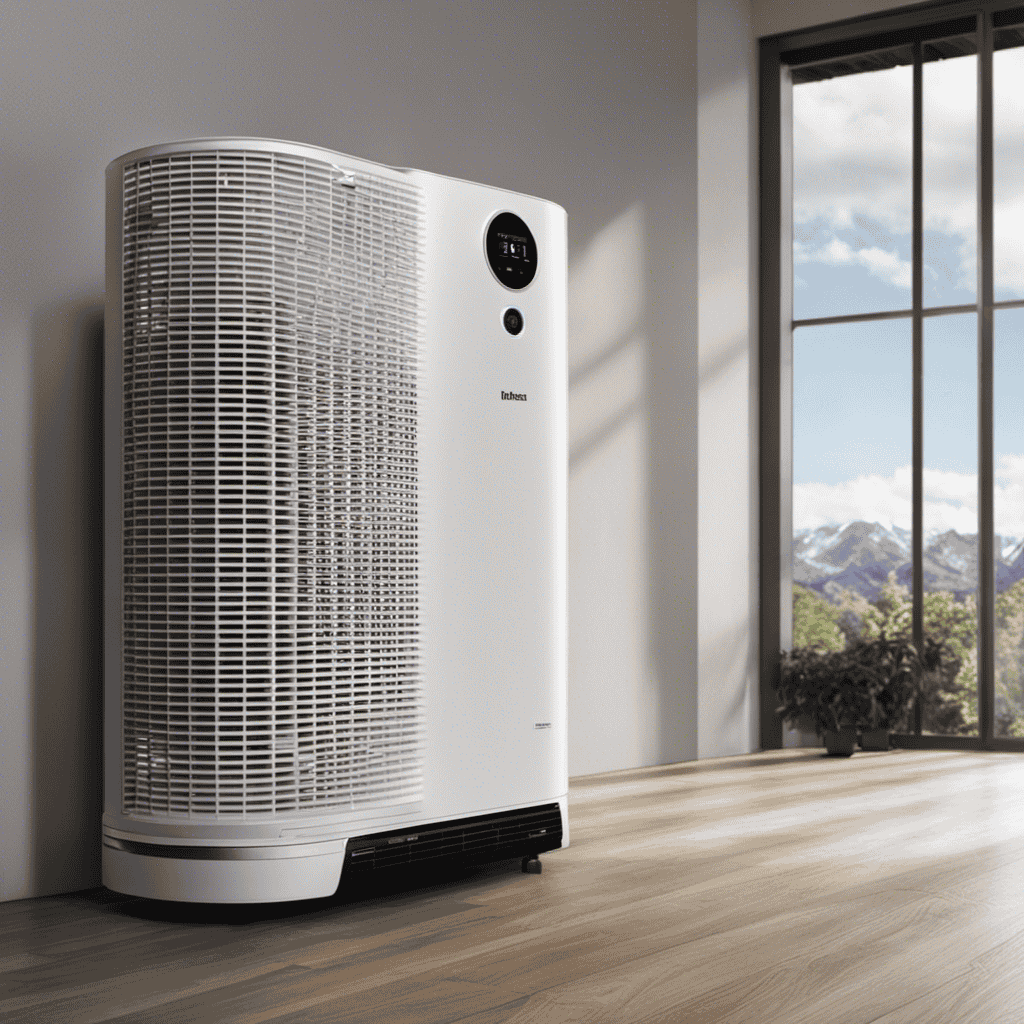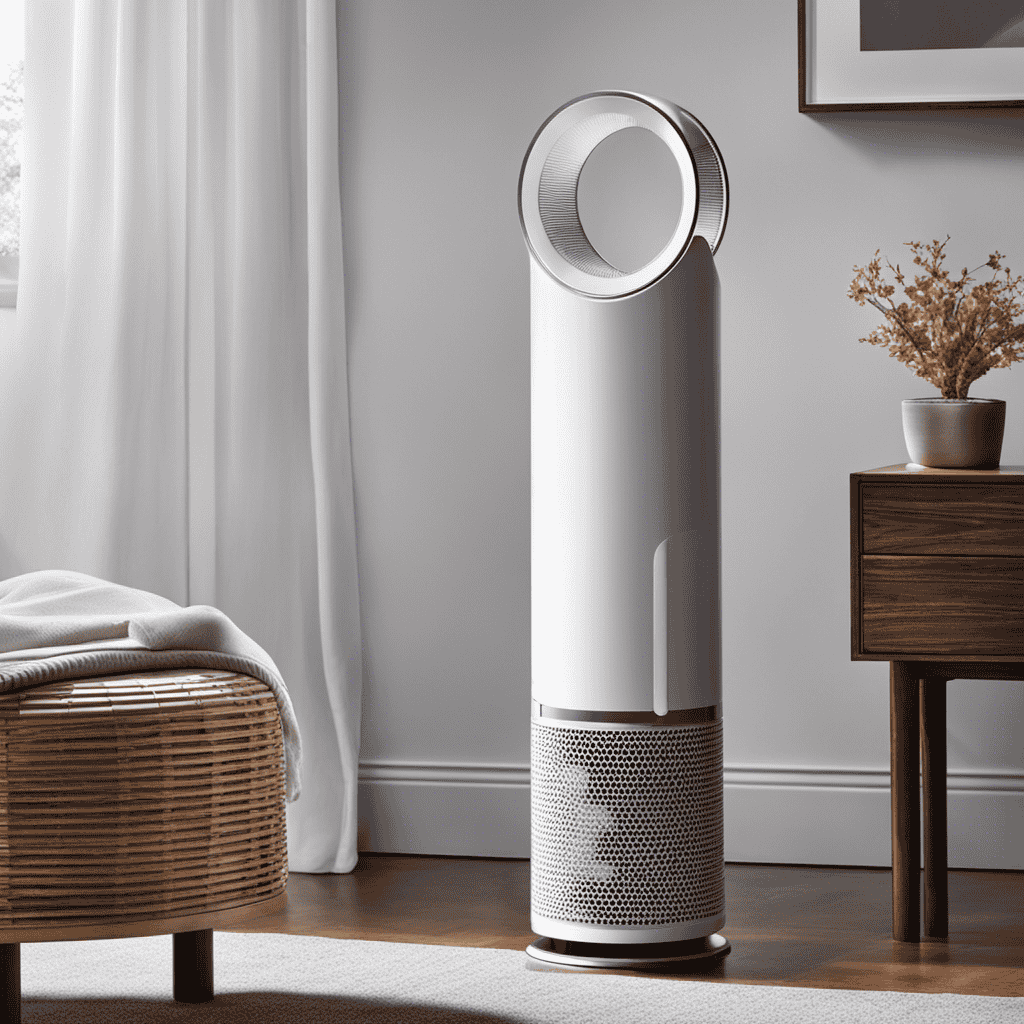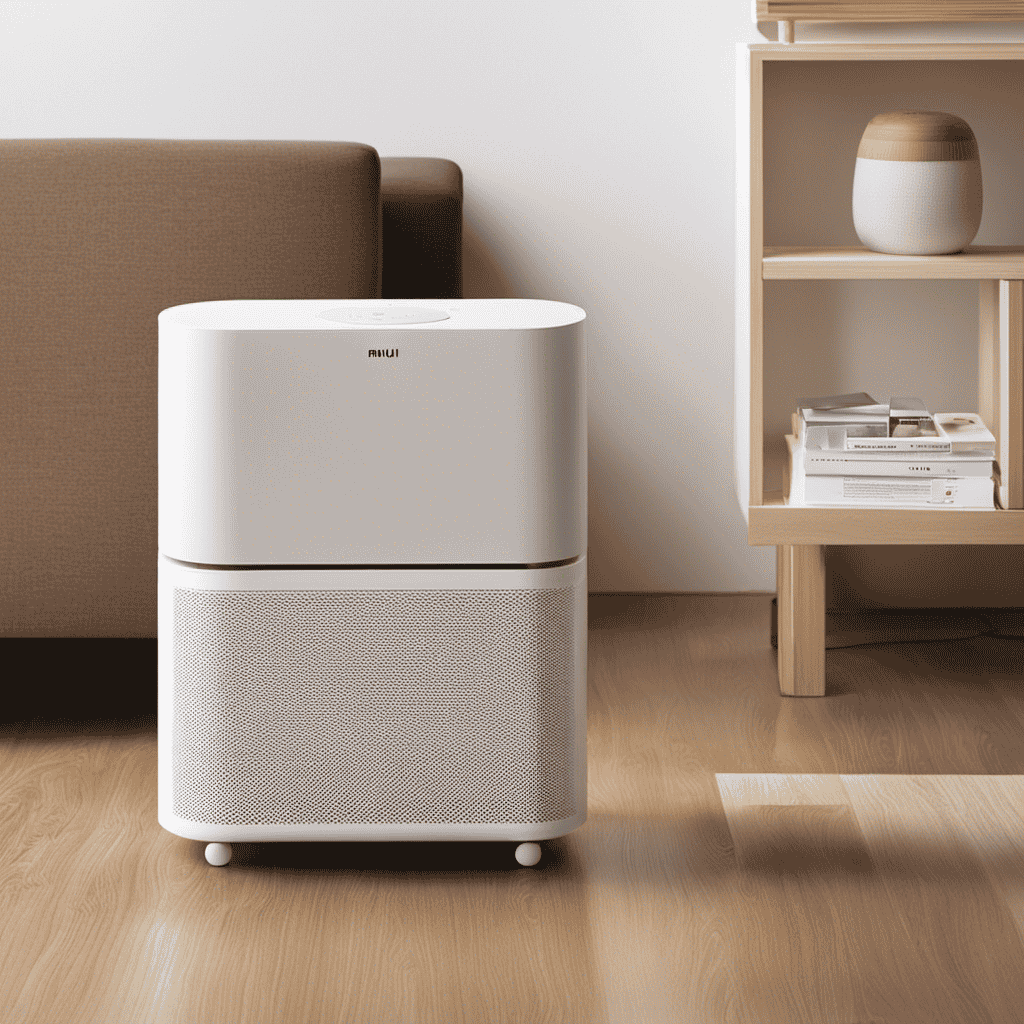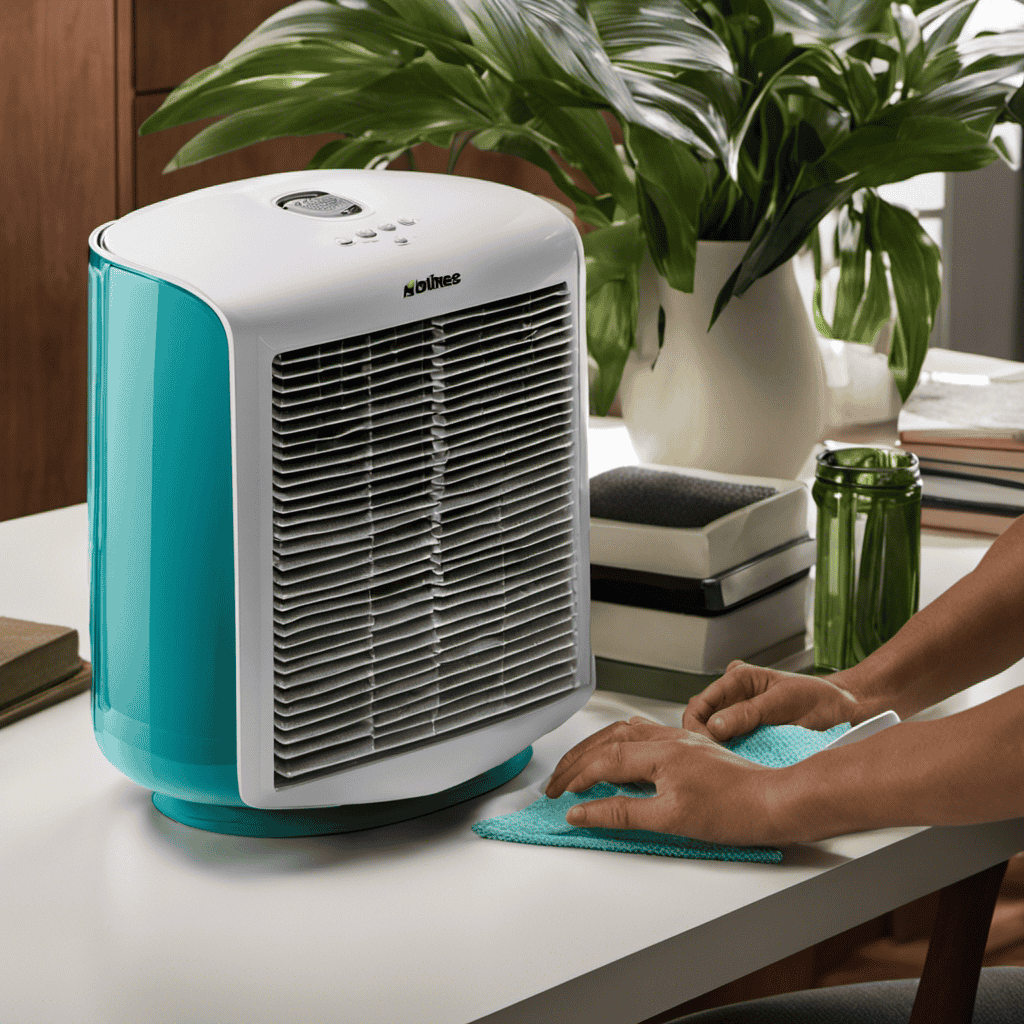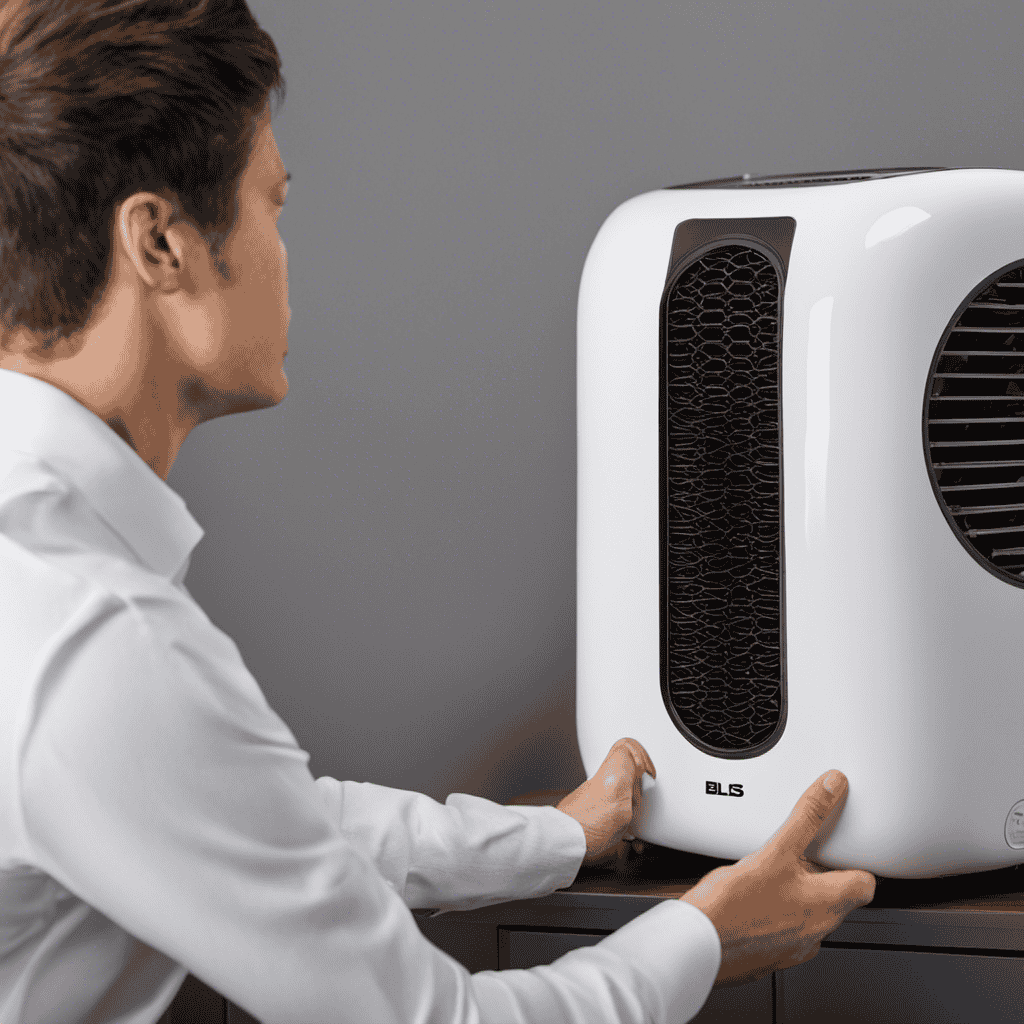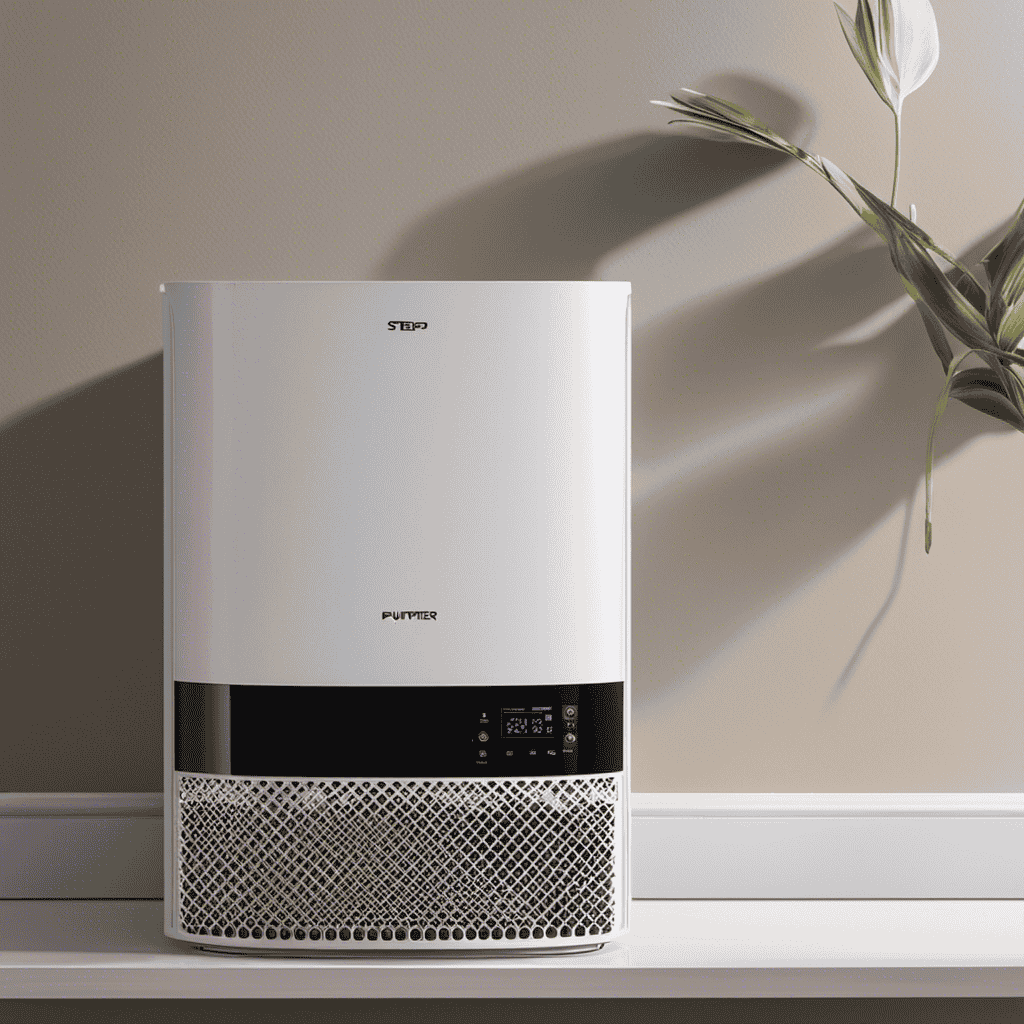As an individual who has battled asthma for many years, I comprehend the significance of discovering effective strategies to control this ongoing condition.
In my quest for a solution, I discovered the power of asthma air purifiers. These devices have become a game-changer in reducing the triggers that can lead to asthma attacks.
In this article, we will explore the role of air purifiers in managing asthma, key features to look for, maintenance tips, and other strategies for improving indoor air quality.
Let’s take a deep breath and dive in.
Key Takeaways
- Asthma is a chronic respiratory condition characterized by inflammation and narrowing of the airways.
- Allergens in the environment, such as dust mites, pet dander, and pollen, are common triggers for asthma attacks.
- Air purifiers can reduce triggers in the environment and improve indoor air quality for asthma sufferers.
- HEPA filters are highly recommended for asthma sufferers as they can effectively trap particles as small as 0.3 microns.
What Is Asthma
What is asthma and how does it affect people’s breathing?
Asthma is a chronic respiratory condition characterized by inflammation and narrowing of the airways, leading to difficulty in breathing. When a person with asthma is exposed to certain triggers, such as allergens, exercise, or cold air, their airways become inflamed and produce excess mucus, causing symptoms like wheezing, coughing, shortness of breath, and tightness in the chest.
Asthma symptoms can vary from person to person and can range from mild to severe. Some individuals may only experience occasional symptoms, while others may have persistent symptoms that significantly affect their daily lives. It is important to note that asthma is a chronic condition, meaning it cannot be cured, but it can be managed with proper treatment and lifestyle changes.
Identifying and avoiding asthma triggers is crucial in managing the condition. Common triggers include pollen, dust mites, pet dander, smoke, pollution, and respiratory infections. By avoiding these triggers, individuals with asthma can minimize the frequency and severity of their symptoms. Additionally, medications such as bronchodilators and anti-inflammatory drugs can help reduce inflammation and open up the airways, providing relief for asthma symptoms.
Common Triggers for Asthma Attacks
One of the most common triggers for asthma attacks is exposure to allergens in the environment. These allergens can include dust mites, pet dander, pollen, mold spores, and even certain foods. When a person with asthma comes into contact with these triggers, their airways can become inflamed and constricted, making it difficult for them to breathe.
Preventing asthma attacks involves identifying and avoiding these triggers as much as possible. This can be done by keeping the home clean and free from dust and pet hair, using mattress and pillow covers to protect against dust mites, and regularly changing air filters. It is also important to keep windows closed during high pollen seasons and to avoid areas with high levels of pollution.
While prevention is key, sometimes it is not always possible to completely eliminate all asthma triggers from the environment. This is where air purifiers can play a role in managing asthma. Air purifiers are designed to filter out allergens and other particles from the air, reducing the amount of triggers in the environment.
In the next section, we will explore the role of air purifiers in greater detail and how they can be beneficial in managing asthma symptoms.
The Role of Air Purifiers in Managing Asthma
To effectively manage your asthma symptoms, it’s important to understand the role that air purifiers can play in reducing triggers in your environment. Asthma air purifiers can be a valuable tool in creating a cleaner and healthier indoor environment. They work by removing airborne particles, such as dust, pet dander, and pollen, which are common triggers for asthma attacks. By reducing the presence of these triggers, air purifiers can help to alleviate symptoms and improve overall air quality.
When considering asthma air purifiers, cost is an important factor to consider. Prices can vary depending on the brand, features, and size of the purifier. It’s important to find a balance between your budget and the effectiveness of the purifier. Look for models that offer a good combination of affordability and performance.
Energy efficiency is another key consideration when choosing an air purifier. Look for models that are Energy Star certified, as these purifiers have been tested and proven to be more energy-efficient. This not only helps to reduce your carbon footprint but also saves you money on your energy bills.
Key Features to Look for in an Asthma Air Purifier
When it comes to choosing an air purifier for asthma, there are several key features to consider.
First, the type of filter used is crucial in capturing and removing allergens from the air. HEPA filters are highly recommended for asthma sufferers as they can effectively trap particles as small as 0.3 microns.
Additionally, it is important to assess the allergen removal effectiveness of the air purifier, which can be determined by checking for certifications such as the AHAM Verified mark.
Lastly, noise level considerations should not be overlooked, as a quiet operation is essential for maintaining a peaceful and comfortable environment.
Filter Types for Asthma
You should consider using HEPA filters for your asthma air purifiers. HEPA stands for High Efficiency Particulate Air, and these filters are designed to trap small particles that can trigger asthma symptoms.
Here are three reasons why HEPA filters are a great choice for asthma sufferers:
-
Filter efficiency: HEPA filters are able to capture particles as small as 0.3 microns with an efficiency of 99.97%. This means they can effectively remove common asthma triggers like pollen, pet dander, and dust mites from the air.
-
Innovative technologies: HEPA filters often incorporate other innovative technologies such as activated carbon, which helps to eliminate odors and harmful gases. Some models even have antimicrobial coatings to prevent the growth of bacteria and mold.
-
Certified effectiveness: HEPA filters are tested and certified by independent organizations to ensure their performance. Look for air purifiers with a True HEPA certification to guarantee that you are getting a filter that meets the highest standards.
Allergen Removal Effectiveness
HEPA filters are highly effective at removing allergens from the air. These filters use a dense mesh to trap tiny particles, including dust mites, pet dander, and pollen, reducing the levels of these common allergens in your home. When considering allergen avoidance, it is important to choose an air purifier with a HEPA filter. Here is a comparison of common allergens and their removal effectiveness by HEPA filters:
| Allergen | Removal Effectiveness |
|---|---|
| Dust mites | High |
| Pet dander | High |
| Pollen | High |
| Mold spores | Moderate |
| Bacteria and Viruses | Low |
While HEPA filters are effective, it’s important to note that they are not the only solution for allergen avoidance. Natural remedies like regular cleaning, keeping pets out of the bedroom, and using hypoallergenic bedding can also help reduce exposure to allergens. Transitioning to the next section, noise level considerations should also be taken into account when choosing an asthma air purifier.
Noise Level Considerations
It’s important to consider the noise level when choosing an air purifier for asthma. A quiet operation is crucial for those with asthma, as excessive noise can be a trigger for symptoms. When researching air purifiers, look for models that prioritize quiet operation.
Here are three key factors to consider:
-
Noise level: Opt for air purifiers that have a low noise output, typically measured in decibels (dB). Look for models that emit no more than 50 dB, which is equivalent to the sound of a quiet conversation.
-
Energy efficiency: Consider air purifiers that are energy-efficient to minimize electricity consumption. Look for models with an Energy Star certification, as these are designed to consume less power while maintaining high performance.
-
User reviews: Read user reviews to get a sense of the noise level experienced by other customers. This can provide valuable insights into the actual noise output of the air purifier.
Choosing an air purifier with quiet operation and energy efficiency will ensure a peaceful and effective solution for managing asthma symptoms.
Types of Air Purifiers for Asthma
When it comes to finding the best air purifiers for asthma, there are several key factors to consider.
One important consideration is the type of filter used in the purifier. Different filter types, such as HEPA filters or activated carbon filters, can effectively remove allergens and irritants from the air, helping to reduce asthma symptoms.
In this discussion, we will explore the different filter types available and their effectiveness in purifying the air for individuals with asthma.
Best Purifiers for Asthma
One of the best purifiers for asthma is the Blueair Classic 480i. It effectively removes allergens from the air. This purifier stands out for its powerful features:
-
HEPA filtration: The Blueair Classic 480i uses a highly efficient HEPA filter. It captures 99.97% of airborne particles as small as 0.3 microns. This includes dust, pollen, pet dander, and mold spores. It helps reduce triggers for asthma attacks.
-
Activated carbon filter: This purifier has an additional activated carbon filter. It effectively eliminates odors, smoke, and chemical pollutants. This provides cleaner and fresher air for individuals with asthma.
-
Smart technology: The Blueair Classic 480i comes equipped with Wi-Fi connectivity and a smartphone app. Users can monitor and control air quality remotely. It also features an intelligent sensor system that automatically adjusts the fan speed based on real-time air quality data.
Overall, the Blueair Classic 480i is a top choice for asthma sufferers. It offers exceptional air purification and advanced features to improve indoor air quality and enhance asthma management.
Filter Types for Asthma
After discussing the best purifiers for asthma, let’s now delve into the different filter types that are effective for allergen control and air quality improvement.
When it comes to asthma, it’s crucial to choose a purifier with a high-efficiency particulate air (HEPA) filter. These filters are designed to capture particles as small as 0.3 microns, including common asthma triggers like dust mites, pollen, pet dander, and mold spores.
Additionally, activated carbon filters are beneficial for removing odors and chemicals from the air, providing further relief for individuals with asthma. Some purifiers also incorporate antimicrobial filters that help inhibit the growth of bacteria and viruses, promoting a healthier indoor environment.
How to Choose the Right Size Air Purifier for Your Asthma Needs
To choose the right size air purifier for your asthma needs, it’s essential to consider the square footage of the room you plan to use it in. Air purifiers come in various sizes, and choosing the appropriate one can make a significant difference in improving indoor air quality.
Here are three factors to consider when selecting the right size air purifier:
-
Room size: Measure the square footage of the room where you plan to use the air purifier. This will help you determine the appropriate coverage area for the device. For example, if you have a small bedroom measuring around 150 square feet, a compact air purifier with a coverage area of 200 square feet would be sufficient.
-
Clean Air Delivery Rate (CADR): Look for an air purifier with a CADR rating suitable for your room size. The CADR indicates how effectively the purifier can remove pollutants such as dust, pollen, and smoke. Higher CADR ratings mean faster and more efficient purification.
-
Air changes per hour (ACH): Consider the number of times the air purifier can filter the entire room’s air in one hour. A higher ACH rating indicates more frequent air purification, which is beneficial for asthma sufferers.
Understanding HEPA Filters and Their Benefits for Asthma Relief
When it comes to managing asthma, HEPA filters can play a crucial role in providing relief. These filters are designed to capture and trap tiny particles in the air, including common asthma triggers like pollen, dust mites, and pet dander.
The benefits of using HEPA filters include improved indoor air quality, reduced exposure to allergens, and potentially fewer asthma symptoms.
HEPA Filters for Asthma
If you have asthma, HEPA filters can help to remove allergens from the air in your home. Here are three benefits of using HEPA filters in air purifiers:
-
Efficient allergen removal: HEPA filters are designed to trap tiny particles as small as 0.3 microns, including common asthma triggers like dust mites, pollen, pet dander, and mold spores. This helps to improve indoor air quality and reduce the risk of asthma attacks.
-
Improved respiratory health: By removing allergens from the air, HEPA filters can help to reduce asthma symptoms and improve respiratory health. Cleaner air can lead to fewer asthma flare-ups, better breathing, and a more restful sleep.
-
Trusted air purifier brands: Many reputable air purifier brands offer models with HEPA filters, such as Dyson, Honeywell, and Blueair. These brands have a proven track record of producing high-quality air purifiers that effectively remove allergens and provide relief for asthma sufferers.
Benefits of HEPA Filters
Using HEPA filters can significantly improve indoor air quality and reduce the risk of asthma attacks. HEPA filter technology is designed to capture 99.97% of particles as small as 0.3 microns, ensuring cleaner and healthier air. The benefits of clean air are numerous, especially for individuals with asthma. Clean air can help alleviate symptoms such as coughing, wheezing, and shortness of breath. It can also reduce the frequency and severity of asthma attacks, allowing individuals to lead a more active and fulfilling life.
Additionally, clean air promotes better sleep, improves concentration, and enhances overall well-being. Investing in a HEPA air purifier is a worthwhile choice for anyone looking to improve their indoor air quality and enjoy the benefits of clean air.
Best Air Purifiers for Asthma: A Comprehensive Review
The best air purifiers for asthma are those that effectively filter out allergens and pollutants from the air. These purifiers provide relief to individuals suffering from asthma by removing harmful particles that can trigger asthma symptoms. One of the key features to look for is a HEPA filter, which stands for High-Efficiency Particulate Air.
Here are three key benefits of using air purifiers with HEPA filters:
-
Improved air quality: HEPA filters can capture microscopic particles such as dust mites, pet dander, pollen, and mold spores, which are common triggers for asthma attacks. By removing these allergens from the air, HEPA filters help create a cleaner and healthier environment.
-
Reduced respiratory symptoms: With cleaner air, individuals with asthma experience a decrease in respiratory symptoms such as coughing, wheezing, and shortness of breath. This can lead to a better quality of life and improved overall well-being.
-
Enhanced sleep: Air purifiers with HEPA filters can also improve sleep quality for asthma sufferers. By reducing airborne irritants, they minimize nighttime asthma symptoms, allowing for a more restful and uninterrupted sleep.
In order to maximize the benefits of air purifiers for asthma, regular maintenance is crucial. Here are some maintenance tips to keep in mind:
-
Filter replacement: HEPA filters should be replaced as recommended by the manufacturer, usually every 6 to 12 months. This ensures that the filter continues to effectively capture allergens and pollutants.
-
Cleaning: Regularly clean the exterior of the air purifier to remove dust and dirt buildup, which can affect its performance.
-
Air purifier placement: Position the air purifier in a central location in the room to ensure optimal air circulation and filtration.
How to Properly Use an Air Purifier for Asthma
To properly utilize an air purifier for your asthma, make sure you follow the recommended maintenance tips and keep the device in a central location for optimal air circulation. Understanding different types of air pollutants and choosing the right air purifier for your home are essential for managing your asthma symptoms effectively.
Air pollutants can trigger asthma attacks and worsen respiratory symptoms. These pollutants can include dust mites, pollen, pet dander, mold spores, and volatile organic compounds (VOCs). An air purifier can help remove these pollutants from the air, creating a cleaner and healthier environment for asthma sufferers.
When selecting an air purifier, consider the following factors: the size of the room, the type of filtration system, and the Clean Air Delivery Rate (CADR). The CADR measures the amount of clean air a purifier can deliver per minute, so a higher CADR is preferable for better air purification.
Maintenance is crucial to ensure the effectiveness of your air purifier. Regularly clean or replace the filters according to the manufacturer’s instructions. Additionally, keep the device in a central location to maximize air circulation throughout the room.
Maintenance Tips for Asthma Air Purifiers
Regularly cleaning or replacing filters is crucial for maintaining the effectiveness of your asthma air purifier. Here are some maintenance tips and cleaning techniques to ensure your purifier continues to provide clean and fresh air:
-
Vacuum the exterior: Dust and dirt can accumulate on the exterior of the purifier, hindering its performance. Use a soft brush attachment on your vacuum cleaner to gently remove any dust or debris.
-
Clean the filters: Depending on the type of purifier you have, the filters may need to be cleaned or replaced. Follow the manufacturer’s instructions for proper cleaning techniques. This will help remove allergens, dust, and other particles from the air.
-
Wipe down the unit: Use a soft cloth dampened with a mild, non-abrasive cleaner to wipe down the exterior of the purifier. This will help remove any dirt or grime that may have accumulated over time.
Additional Strategies for Improving Indoor Air Quality for Asthma Sufferers
Now that we have discussed maintenance tips for asthma air purifiers, let’s explore additional strategies for improving indoor air quality for asthma sufferers.
Two key areas to focus on are improving ventilation and reducing chemical exposure.
Improving ventilation is crucial for maintaining clean indoor air. Opening windows and doors regularly allows fresh air to circulate and helps remove pollutants. Additionally, using exhaust fans in kitchens and bathrooms can help remove odors and moisture, reducing the risk of mold growth. Installing a mechanical ventilation system can also be beneficial, as it continuously brings in fresh air while expelling stale air.
Reducing chemical exposure is another important step in improving indoor air quality. Many household products, such as cleaning agents, air fresheners, and paints, contain volatile organic compounds (VOCs) that can trigger asthma symptoms. Opting for natural cleaning products or those labeled as VOC-free can help minimize exposure. It is also advisable to avoid smoking indoors and to limit the use of scented candles and fragrances.
Asthma Air Purifiers Vs. Humidifiers: Which Is Right for You
Improving ventilation and reducing chemical exposure are key factors to consider when deciding between an asthma air purifier and a humidifier. Both devices have their benefits, but understanding the specific needs of asthma sufferers is crucial in making the right choice.
Here are three important points to consider when comparing air purifiers and humidifiers for asthma:
-
Air Purifiers: These devices are designed to remove airborne allergens and pollutants, such as dust mites, pet dander, and mold spores. They work by using filters or electrostatic technology to trap particles and improve indoor air quality. Air purifiers can be particularly beneficial for asthma sufferers, as they help reduce exposure to triggers that can cause asthma attacks.
-
Dehumidifiers: High humidity levels can promote the growth of mold and dust mites, which are common triggers for asthma. Dehumidifiers help reduce moisture in the air, creating an environment that is less favorable for these allergens to thrive. However, it’s important to note that dehumidifiers do not remove airborne particles like air purifiers do.
-
Choosing the Right Device: To determine whether an asthma air purifier or a humidifier is more suitable, it’s essential to assess the specific needs of the individual with asthma. If the primary concern is removing airborne allergens and pollutants, an air purifier would be the better choice. On the other hand, if the main issue is high humidity levels and the growth of mold or dust mites, a dehumidifier may be more effective.
Ultimately, a comprehensive approach to managing asthma symptoms should include both maintaining good indoor air quality and controlling humidity levels. Consulting with a healthcare professional can provide further guidance in selecting the most appropriate device for individual needs.
Frequently Asked Questions About Asthma Air Purifiers
If you’re considering an air purifier for your home, you might be wondering if it will help with your asthma symptoms. The good news is that air purifiers can be beneficial for people with asthma. They work by filtering out airborne particles such as dust, pollen, pet dander, and mold spores, which can trigger asthma attacks. By removing these irritants from the air, air purifiers can help create a cleaner and healthier environment for asthma sufferers.
When looking for an air purifier for asthma, it’s important to choose a reputable brand that specializes in air purification. Some popular air purifier brands known for their effectiveness include Honeywell, Blueair, Coway, and Winix. These brands offer a range of models with different features and filtration systems, so you can choose one that best suits your needs and budget.
Speaking of budget, the cost of asthma air purifiers can vary depending on the brand, model, and features. On average, you can expect to spend anywhere from $100 to $500 for a good quality air purifier. While this may seem like a significant investment, it’s important to consider the long-term benefits it can provide for your health.
Will an air purifier help with asthma symptoms?
Yes, air purifiers can provide asthma relief with purifiers by removing airborne irritants like dust, pet dander, and mold spores. This can help reduce asthma symptoms and improve overall air quality, creating a healthier environment for asthma sufferers. Using a purifier alongside other asthma management strategies can make a significant difference.
Frequently Asked Questions
Can Asthma Air Purifiers Completely Eliminate Asthma Triggers From Indoor Air?
Asthma air purifiers can be effective in reducing asthma triggers from indoor air. However, it’s important to note that they may not completely eliminate all triggers.
Different types of air purifiers can vary in their effectiveness for asthma relief. Research and evidence-based studies can help in comparing and selecting the most suitable air purifier for asthma management.
It’s always recommended to consult with healthcare professionals for personalized advice on managing asthma triggers.
Do I Still Need to Take My Asthma Medication if I Use an Air Purifier?
Well, isn’t this a dilemma!
I mean, if I have an air purifier that claims to eliminate asthma triggers from indoor air, wouldn’t that mean I can ditch my asthma medication?
But alas, the truth is, an air purifier can be a helpful alternative treatment for asthma, reducing the presence of triggers like dust and pollen.
However, it is important to note that asthma medication is still necessary for managing symptoms and controlling inflammation.
Can an Air Purifier Worsen Asthma Symptoms?
An air purifier can worsen asthma symptoms if it is not effective or properly maintained.
It is important to choose an air purifier that specifically targets asthma triggers, such as dust mites, pet dander, and pollen.
Regular maintenance, such as cleaning or replacing filters, is necessary to ensure the purifier continues to function optimally.
If an air purifier is not effectively removing allergens from the air or if it becomes clogged with particles, it may actually contribute to worsening asthma symptoms.
How Often Do I Need to Replace the Filters in an Asthma Air Purifier?
To answer the question about how often filters need to be replaced in an asthma air purifier, it is important to consider factors such as the manufacturer’s recommendations and the specific model of the air purifier.
Generally, it is recommended to replace the filters every 6 to 12 months, or as indicated by the manufacturer. Regular filter replacement ensures optimal performance and effectiveness in removing asthma triggers from the air.
Can I Use an Asthma Air Purifier in Multiple Rooms of My House?
Yes, you can definitely use an asthma air purifier in multiple rooms of your house.
Using asthma air purifiers in small spaces has several benefits. They help remove allergens, such as dust, pollen, and pet dander, from the air, reducing the risk of asthma attacks. Additionally, they can help eliminate odors and harmful gases, improving indoor air quality.
It’s important to choose a purifier that is suitable for the size of each room to ensure optimal performance.
Conclusion
In conclusion, asthma air purifiers play a crucial role in managing asthma symptoms by removing common triggers from the air. With features like HEPA filters and activated carbon, these purifiers effectively capture and neutralize allergens, pollutants, and irritants.
Regular maintenance is important to ensure their optimal performance. Additionally, implementing other strategies like keeping a clean living environment and reducing exposure to triggers can further improve indoor air quality for asthma sufferers.
Remember, choosing the right air purifier can make a significant difference in managing asthma symptoms and ensuring a healthier living space.

